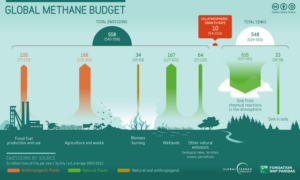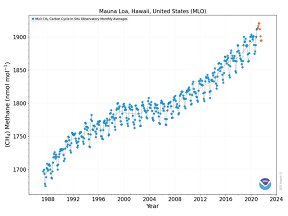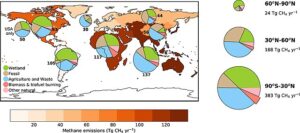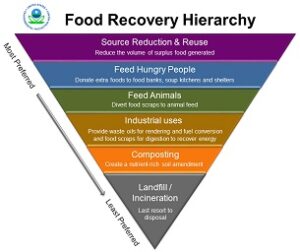Methane is a very powerful greenhouse gas. It has 82.5 times more warming potential than CO2 over a 20-year timespan. But fortunately, it lives shortly in the atmosphere: it degrades in 12 years. Therefore, methane mitigation is a key opportunity to slow down the rate of global warming. Observers call this the low-hanging fruit of climate action.

A new report Methane Matters: A comprehensive approach to methane mitigation spells out quick actions for methane mitigation. It was released by the Changing Markets Foundation, the Environmental Investigation Agency and the Global Alliance for Incinerator Alternatives. Following the recommendations of the report would result in a significant reduction of methane emissions.
But the trends are rising
Current trends aren’t favourable. The year 2021 was registered as the fifth-hottest year in the past 52 years according to the EU’s Copernicus Climate Change Service, while the last seven years rank as the hottest on record overall. Globally, in 2021, temperatures were on average 1.2°C higher than preindustrial levels. And methane emission trends are on the rise as well. They point to an increase by more than 15% by 2030, from the Glasgow climate conference onwards; 8% higher than the 2020 emissions. These will then amount to nearly 380 million tons per year. Even though more than 110 countries have committed to the Global Methane Pledge. This has the collective goal of reducing global methane emissions by 30 per cent by 2030, compared to 2020 levels.

And then, the Pledge even falls short of the ambition to keep global warming below 1.5°C. According to the UN Environment Programme’s Global Methane Assessment (GMA), methane emissions should be reduced by at least 45% in this critical decade of climate action. The methane mitigation report investigates the actions required to reach that goal. It contains expert assessments on three critical methane emitting sectors: agriculture, energy and waste.
Agriculture
Agriculture is the largest source of anthropogenic methane emissions. More sustainable food consumption and food production techniques are essential for methane mitigation. Technical measures are available today that can reduce methane emissions from ruminal livestock by around 30 million tons by 2030. One of these measures is the improvement of feed quality. Better feed additives and supplements can inhibit the bacteria in the rumen that produce methane. Better manure management will also reduce emissions. Rice production in paddies also produces methane. In general, the longer rice fields are continuously flooded, the greater the methane emissions. Consequently, any technique that reduces continuous flooding tends to support methane mitigation.
But these technical measures do not add up to the required emissions reduction. They need to be backed up by the adoption of diets that emit less methane in the production chain. Governments should therefore adopt policy measures that promote healthier diets for mankind. Meaning: largely plant-based diets, and diets with less and better meat and dairy. Promoting meat-free diets in public institutions. Set national targets. Tax meat and subsidize the vegetal alternative. Regulate meat and dairy companies: ask them to report on their methane emissions, with an eye on reducing them. In general, formulate a policy roadmap for methane mitigation. Whereas the energy sector has formulated such a roadmap already (the IEA’s Net Zero by 2050 initiative), this doesn’t yet exist for the agricultural sector.
There is an extra benefit to such methane mitigation in the agricultural sector. Public health will increase if meat consumption would come down: less heart diseases, cancer and diabetes. Moreover, there will be less emissions of other greenhouse gases as well. Less CO2 (because the meat sector is so inefficient) and less NOx (emitted from fertilized land).

Energy
The energy sector presents opportunities for significant methane mitigation at zero to low cost with existing technologies and best practices. For oil and gas, this includes leak detection and repair. Detection can very well be done nowadays through satellites. ‘Super-emitters’ have a major impact. In the energy sector, just 5% of methane leaks contribute to 50% of the emissions. In addition to that, venting methane to the air should be banned. Much methane is vented to the atmosphere by inactive wells and coal mines. The UsA alone has 3.2 million inactive oil and gas wells. These leak much methane and should be capped. Moreover, methane is vented routinely from active coal mines; these gases should be treated. A more coal mines will be closed in the coming decade, monitoring and treating the vented gases will become urgent.
As a whole, the energy sector has many opportunities to reduce methane leakages. As it will have to scale down in the near future, we need to support it in performing the public task of methane mitigation.
Waste
The waste sector is the third-largest source of anthropogenic methane emissions worldwide. It contributes roughly 20% of all such emissions. Methane in the waste sector is produced when biodegradable material (such as food, garden clippings, human waste, wood and paper) breaks down in environments low in oxygen. Like dumpsites, landfills or some sewage treatment equipment.

The organic waste sector often works with the so-called waste hierarchy. This prioritizes the actions that are most favourable to society and do the least damage to the environment. Top of the list is waste prevention: if we don’t produce waste, it cannot have unfavourable effects (line methane emissions). Then, waste may still be in good condition to feed to humans or animals. It can be used as a feedstock in industry. If we cannot use organic waste, we can still compost it. The ultimate solution, if there are no other use for the waste, we can landfill it. We will often have to treat waste streams. Separate or stabilize them, treat them with chemicals. All actions taken together, mankind can in principle reduce solid waste methane emissions by as much as 95% by 2030. On top of that, waste treatment can create more and better jobs than simple disposal. And a more stable, dignified livelihood for workers in the informal waste sector.
Policy
Agricultural, energy and waste organizations should formulate policies for methane mitigation. In addition to that, governments should monitor and, if necessary, coordinate such actions. Monitoring, reporting and verification (MRV) are essential to the realization of such policy goals. National governments should step in and provide a policy framework – now often absent. The International Methane Emissions Observatory could provide satellite surveillance; they could verify if promises are being kept; they could warn for super-emissions. Collective action on methane will also require technical assistance to policymakers and financial assistance to developing countries.
Again, there are public benefits to be gained. Public health will improve. Because methane is important in ground-level formation of ozone, cutting emissions by 45% could prevent 255,000 premature deaths and 775,000 asthma-related hospital visits each year. Moreover, new jobs will be created. Municipalities will reduce costs. And if the world should be able to formulate a coherent strategy, that could serve as an example to cut all greenhouse gas emissions.
In short, the world needs to develop a new attitude towards methane emissions. Feel a need of urgency and act accordingly – both critical sectors and governments. And erect a solid global system of monitoring, reporting and verification.
Interesting? Then also read:
Methane emissions cause concern
Methane pyrolysis turns a grey resource into a green one
Methane emissions may threaten Paris climate agreement
